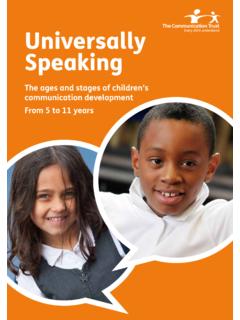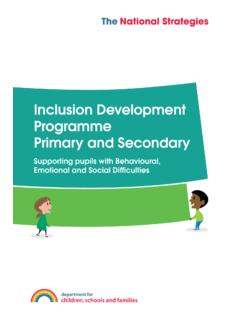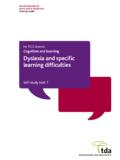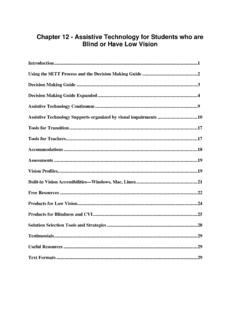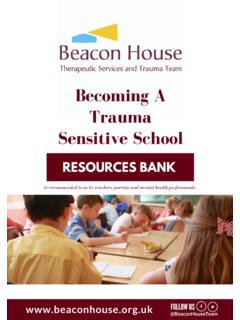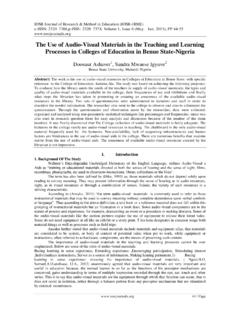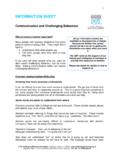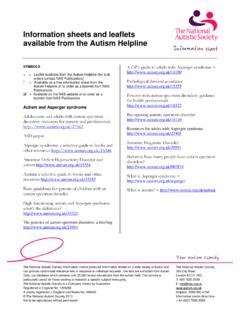Transcription of Including students with SEN and/or disabilities in ...
1 Special educational needs and/or disabilitiesTraining toolkitFor secondary PGCE tutors and trainees Including students with SEN and/or disabilities in secondary mathematicsIncluding students with SEN and/or disabilities in secondary mathematics2 Contents1 Including students with SEN and/or disabilities in secondary mathematics lessons 32 Removing barriers to the secondary mathematics curriculum for students with SEN and/or disabilities 63 Self-audit for inclusive mathematics lessons: planning teaching, learning and support 74 Mathematics and Every Child Matters 235 Early development in the National Curriculum: the P scales for mathematics 246 Bilingual learners 257 Sources of information and advice 263 Including students with SEN and/or disabilities in secondary mathematicsIncluding students with SEN and/or disabilities in secondary mathematics lessons1 IntroductionThis booklet gives tutors and trainees information about subject-specific issues in the mathematics curriculum for students with SEN and/or disabilities .
2 It offers a straightforward introduction to planning inclusive mathematics lessons. There are also suggestions for further reading and support in section booklet in this series contains a self-audit table (section 3). This offers a range of ideas that you can use to check against your practice and the practice you observe. The organisation of information in this table is based on the most recent research evidence and the views of expert evidence (eg Davis and Florian, 2004) suggests that much of what has traditionally been seen as pedagogy for students with SEN and/or disabilities consists of the approaches used in ordinary teaching, extended or emphasised for particular individuals or groups of students . This applies even when teaching approaches may look very different, eg when teachers are working with students with complex needs. Trials of these materials in 2007/08 suggested that grouping teaching approaches into themes helps new teachers and those who work with them to consider and discuss their practice.
3 Therefore each self-audit table is grouped under eight themes:maintaining an inclusive learning environment "multi-sensory approaches, Including information and communication technology (ICT) "working with additional adults "managing peer relationships "adult-student communication "formative assessment/assessment for learning "motivation, and "memory/consolidation. "There are many overlaps between these themes, but the model offers a useful starting point to help you develop teaching approaches that include students with SEN and/or disabilities . 4 Including students with SEN and/or disabilities in secondary mathematicsMathematics Mathematics equips pupils with uniquely powerful ways to describe, analyse and change the world. It can stimulate moments of pleasure and wonder for all pupils when they solve a problem for the first time, discover a more elegant solution, or notice hidden connections. Pupils who are functional in mathematics and financially capable are able to think independently in applied and abstract ways, and can reason, solve problems and assess risk.
4 Mathematics is a creative discipline. The language of mathematics is international. The subject transcends cultural boundaries and its importance is universally recognised. Mathematics has developed over time as a means of solving problems and also for its own sake. National Curriculum, QCA, 2009 Roles and responsibilitiesRecent legislation and guidance make clear that all the teaching staff in a school are responsible for the provision for students with SEN and/or disabilities . All staff should be involved in developing school policies and fully aware of the school s procedures for identifying, assessing and making provision for students with SEN and/or disabilities . Staff should help students with SEN to overcome any barriers to participating and learning, and make any reasonable adjustments needed to include disabled students in all aspects of school Disability Discrimination Act (DDA) has substantial implications for everyone involved in planning and teaching the curriculum.
5 Schools have specific duties under the DDA to:make reasonable adjustments to their policies and practice to prevent discrimination against "disabled studentsincrease access for disabled students , Including access to the curriculum, through accessibility "planning, and promote disability equality and have a disability equality scheme showing how they will do so. "These duties are important and significant. They require schools to: take a proactive, systematic and comprehensive approach to promoting disability equality and "eliminating discrimination, and build disability equality considerations in from the start at every level of activity, Including "developing and delivering the curriculum and classroom practice. Schools must address their various DDA duties together in a way that brings greater benefits to disabled students , staff, parents and other users of the school. Using the self-audit table in this booklet to develop an inclusive approach to your teaching will help you carry out these duties in your students with SEN and/or disabilities in secondary mathematicsModifying the curriculum and the National Strategies to match students needs Teachers have a statutory duty to modify the programmes of study (or National Strategy materials).
6 Schools have a responsibility to provide a broad and balanced curriculum for all pupils. National Curriculum, QCA, 2008 This is more than just giving students access to the curriculum . The curriculum is not immovable, like some building, to which students with SEN and/or disabilities have to gain access. It is there to be changed, where necessary, to include all students . The statutory inclusion statement in the National Curriculum sets out a framework for modifying the curriculum to include all students . Teachers have to:set suitable learning challenges "respond to students diverse learning needs, and "overcome potential barriers to learning and assessment for particular individuals and groups "of principles allow you to:choose objectives for students with SEN and/or disabilities that are different from those of the "rest of the group, or modify the curriculum to remove barriers so all students meet the same objectives. "Planning for students with SEN and/or disabilities should be part of the planning that you do for all students , rather than a separate activity.
7 It doesn t need to be complicated or time-consuming. You can simply jot down brief notes in your lesson plans on the learning objectives and approaches you will use to remove barriers for students with SEN and/or disabilities . Any personal targets the student has can inform this planning. At times it may be appropriate to plan smaller steps to achieve the learning goal or provide additional resources. It is often possible to use the support available to do this, either from the SENCO or teaching assistant/mentor. You should also think about the questions you will ask different groups and individuals and the ways you will check that students understand. Some students with SEN and/or disabilities will show they understand in different ways from their peers, so you should look at a range of opportunities for students to demonstrate what they know and can do. 6 Including students with SEN and/or disabilities in secondary mathematicsRemoving barriers to the secondary mathematics curriculum for students with SEN and/or disabilities 2 Teaching and learningTo make mathematics lessons inclusive, teachers need to anticipate what barriers to taking part and learning particular activities, lessons or a series of lessons may pose for students with particular SEN and/or disabilities .
8 So in your planning you need to consider ways of minimising or reducing those barriers so that all students can fully take part and learn. In some activities, students with SEN and/or disabilities will be able to take part in the same way as their peers. In others, some modifications or adjustments will need to be made to include some activities, you may need to provide a parallel activity for students with SEN and/or disabilities , so that they can work towards the same lesson objectives as their peers, but in a different way eg using tactile equipment for work relating to shape, space and measures rather than two-dimensional visual , students with SEN and/or disabilities will have to work on different activities, or towards different objectives, from their peers. There are some examples in the checklist in section assessing students , you need to plan carefully to give students with SEN and/or disabilities every opportunity to demonstrate what they know and are able to do, using alternative means where students with SEN and/or disabilities in secondary mathematicsSelf-audit for inclusive mathematics lessons: planning teaching, learning and support 3 You can use the following checklist to audit your practice and plan for more inclusive lessons.
9 The left-hand column of the table suggests approaches that are appropriate for students with SEN and/or disabilities in all subjects. The right-hand column suggests extensions and emphases that may be helpful in removing barriers for students with SEN and/or disabilities in most cases, the actions recommended are good practice for all students , regardless of their particular SEN and/or disability. In other cases, the actions taken will depend on the barriers to taking part and learning identified in relation to the lesson being taught and students particular SEN and/or disabilities . For example, the challenges of Including students with developmental dyscalculia in work on calculations may be quite different from those for Including students with other SEN and/or disabilities . Some young people with identified needs such as behaviour difficulties may benefit from changes in activities or working with selected others or rest breaks.
10 In these cases it is helpful to discuss and plan with a support assistant who knows the young person well. The SENCO, subject associations and/or organisations supporting people with particular SEN/ disabilities may be able to offer more specialist examples are not comprehensive or exhaustive. They are intended to stimulate thinking rather than offer detailed advice on how to teach the subject to students with different types of special educational needs and/or disabilities . You will wish to add your own general or subject-specific ideas to the self-audit students with SEN and/or disabilities in secondary mathematicsMaintaining an inclusive learning environmentMaintaining an inclusive learning environmentMathematicsObservedTried outSound and light issuesFor example:background noise and "reverberation are reducedsound field system is used, "if appropriateglare is reduced "there is enough light for "written workteacher s face can be seen "avoid standing in front of light sources, eg windowsstudents use hearing and "low vision aids, where necessary, andvideo presentations have "subtitles for deaf or hearing-impaired students and those with communication difficulties, where and light issuesInteractive whiteboards are non-reflective to reduce seating and the main board position are planned for the shape of the can see and hear clearly, as necessary.










